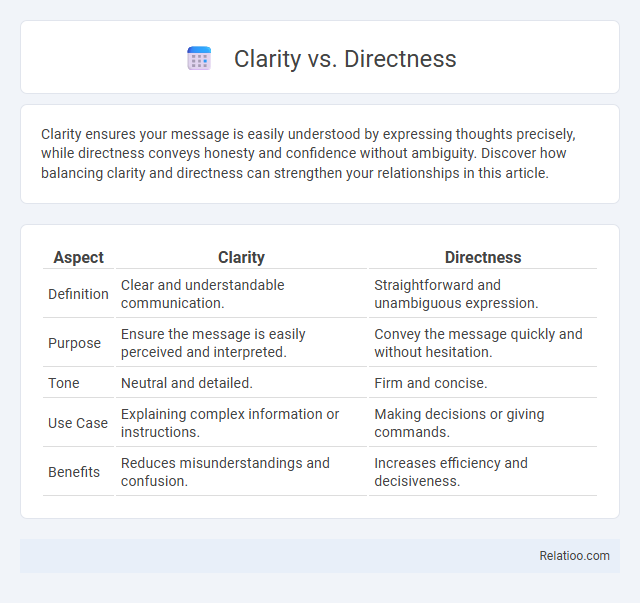Clarity ensures your message is easily understood by expressing thoughts precisely, while directness conveys honesty and confidence without ambiguity. Discover how balancing clarity and directness can strengthen your relationships in this article.
Table of Comparison
| Aspect | Clarity | Directness |
|---|---|---|
| Definition | Clear and understandable communication. | Straightforward and unambiguous expression. |
| Purpose | Ensure the message is easily perceived and interpreted. | Convey the message quickly and without hesitation. |
| Tone | Neutral and detailed. | Firm and concise. |
| Use Case | Explaining complex information or instructions. | Making decisions or giving commands. |
| Benefits | Reduces misunderstandings and confusion. | Increases efficiency and decisiveness. |
Understanding Clarity and Directness
Understanding clarity involves ensuring your message is easily comprehensible by using precise language and straightforward structure. Directness emphasizes delivering your point without unnecessary information, making communication efficient and purposeful. Balancing clarity and directness helps you convey information effectively while maintaining your audience's engagement and comprehension.
Key Differences Between Clarity and Directness
Clarity involves presenting information in a way that is easy to understand and free from ambiguity, ensuring the message is comprehensible. Directness refers to communicating in a straightforward, honest manner without unnecessary detail or circumlocution. The key difference is that clarity emphasizes the ease of understanding, while directness focuses on straightforwardness and honesty in expression.
Why Clarity Matters in Communication
Clarity matters in communication because it ensures your message is easily understood, reducing the risk of misunderstandings and errors. Directness supports clarity by delivering information succinctly and with precision, which is crucial in professional and personal interactions. Prioritizing clear communication enhances trust, fosters efficient collaboration, and drives successful outcomes.
The Benefits of Being Direct
Being direct enhances communication by eliminating ambiguity and ensuring your message is understood quickly and clearly. This approach builds trust and efficiency, especially in professional settings where time and clarity are crucial. Your ability to convey ideas straightforwardly leads to better decision-making and stronger relationships.
When to Prioritize Clarity Over Directness
When communicating complex or sensitive information, prioritize clarity over directness to ensure Your message is fully understood and avoids misinterpretation. Clarity enhances comprehension by using precise language, providing context, and avoiding ambiguity, which is crucial in professional or educational settings. Directness may expedite communication but can sometimes sacrifice nuance, so balancing these elements depends on the audience's needs and the communication goals.
Situations Where Directness Is Essential
Directness is essential in high-stakes situations like emergency responses, legal negotiations, and medical communications where clarity can prevent misunderstandings and save lives. Clarity in language ensures the message is easily understood, but directness prioritizes transparency and brevity to convey urgency or critical information. In these scenarios, combining clarity with directness minimizes ambiguity, fosters quick decision-making, and enhances overall effectiveness.
Balancing Clarity and Directness
Balancing clarity and directness involves delivering messages that are straightforward yet precise, ensuring the audience fully comprehends the intent without ambiguity. Effective communication requires using unambiguous language that avoids unnecessary complexity while maintaining a respectful tone to engage the listener or reader. Mastering this balance enhances understanding, reduces misinterpretations, and fosters more productive interactions in professional and personal contexts.
Common Misconceptions About Direct Communication
Direct communication often gets mistaken for rudeness or insensitivity, yet clarity is the true goal, ensuring your message is understood without ambiguity. Many assume that being direct means ignoring empathy, but effective communication balances brevity with respect for the listener's feelings. Your ability to convey meaning clearly strengthens relationships and prevents misunderstandings that commonly arise from misinterpreted messages.
Strategies for Achieving Both Clarity and Directness
Effective communication balances clarity and directness by prioritizing concise language and straightforward sentence structure. Techniques such as using concrete examples, active voice, and eliminating jargon enhance your message's transparency while maintaining brevity. Employing feedback loops and careful word choice ensures that clarity does not sacrifice directness, making your communication impactful and easy to understand.
Real-World Examples: Clarity vs Directness
Clarity in communication ensures the message is easily understood, exemplified by user manuals that use simple, unambiguous instructions, while directness emphasizes brevity and straightforwardness, such as team leaders giving concise commands during emergency drills. For instance, a customer service representative might use clarity by explaining a refund process in detail, whereas directness would involve stating, "Your refund will be processed within 5 days." Real-world applications show that combining clear explanations with direct language improves comprehension and efficiency in business and everyday interactions.

Infographic: Clarity vs Directness
 relatioo.com
relatioo.com